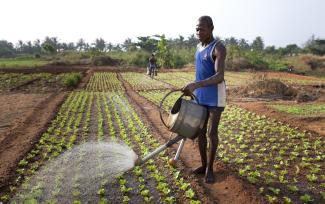Infrastructure
A brief history of irrigation

The so-called "Green Revolution" of the 1960s and ‘70s was supposed to bring about a massive rise in both staple-food production and rural incomes. Irrigation was a major part of it , along with new seed, fertiliser, pest control and expanding the area of arable land. In Asia in particular, impressive results were achieved in the fight against hunger and poverty. This is still evident in key statistics today: only 20 % of the world’s farmland is irrigated, yet it accounts for 40 % of global harvests, and about 60 % of all irrigated land is in South and East Asia. (Siebert/Döll 2011).
However, the extreme rise in production and increasing commercialisation of agriculture had unwelcome side-effects, including land exhaustion, environmental pollution with pesticides and fertilisers, the salinisation of soils and excessive water consumption. Scholars therefore increasingly point out a lack of environmental sustainability (Conway/Barbier 2013). Moreover, many economic expectations were not fulfilled. Hunger was effectively curbed in many places, but the prosperity generated by agriculture was often very unevenly distributed.
Expand irrigation – especially in Africa
The challenges have actually grown, not diminished since the Green Revolution. All forecasts say that a significant increase in agricultural production is needed to feed the growing world population. There is only limited scope for clearing more farmland – and the remaining land reserves are greatest in Africa (McKinsey Global Institute 2010), and some farmland is likely to be lost to climate change. A large share of the additional production humanity needs must therefore come from more intensive land use. At the same time, the environmental balance must not be disrupted even more. This challenge can be expressed in the simple demand: "Produce more, with less, and better" (European Commission 2011). More irrigation will certainly be a key component.
Africa deserves special attention in this context. In comparison to Asia, where 37 % of arable land is irrigated, Africa’s potential is still mostly untapped with an irrigation ratio of only around six percent (You 2010). Adequate technology for expanding irrigation and making best use of scarce water resources is available and well understood. Yet, how must irrigation agriculture be organised in order to avoid the mistakes of the Green Revolution?
Since it was established in 2000, the Independent Evaluation Department of KfW development bank has conducted ex-post evaluations to assess the impact of 36 irrigation projects that got funding from Germany’s Federal Government in 14 different countries. This includes 23 projects in eight African countries. In over 60 % of all cases, the assessments were positive. The other 40 % of projects, however, were judged to have unsatisfactory or even clearly inadequate outcomes. The early projects, in particular, failed to deliver good results.
Statism failures
These initial projects were designed in the early 1980s and strongly influenced by the Green Revolution. The key organisational role was usually assigned to the partner country’s government as relying on the state was considered the best way to speed up the Green Revolution at the time. Accordingly, the irrigation infrastructure tended to be centrally organised by state authorities, and often they directed input supply and cropping patterns as well. It has to be remembered that at that time many developing countries were still largely closed to international agricultural markets and private-sector players. So, this "first generation" of irrigation projects was largely supposed to result in national self-sufficiency in staple foods. Farmers had little opportunity to actively shape the irrigation schemes or get involved in their management. Likewise, they were under no obligation to maintain them.
As a result, these projects failed to meet expectations; the success rate was only about 35 %. Typical problems included improper use, poor maintenance and low productivity. That was the case in Madagascar and Morocco for example. Further problems occurred when economies in partner countries were opening up to international markets and the schemes should have been adapted to the needs of private-sector businesses and market competition. All too often there was no political will to implement this kind of reforms and boost competitiveness. KfW is not alone in reaching these disappointing conclusions. Evaluations of first-generation irrigation systems on behalf of the World Bank and the Asian Development Bank (ADB) paint a similar picture (ADB 1995; Jones 1995).
The second generation
Given that the first schemes provided too few incentives for farmers, project designers began to pay more attention to involving this target group in the management of schemes in the late 1980s. The catchword was "participatory irrigation management". This was in line with German thinking on development assistance, with a new emphasis on beneficiaries’ participation and poverty reduction. Henceforth, involving smallholders was a priority.
Simply put, second-generation projects were based on the maxim "small is beautiful". Aspects such as market orientation or commercialisation still did not play a major role, partly because world-market prices for agricultural goods remained low until 2008.
The focus was on raising the incomes of small farmers. Appropriate low-maintenance irrigation systems were supposed to help them produce food for their own consumption as well as local markets. Organisation in user groups was expected to boost effectiveness. However, the governments of developing countries were not always quick to accept the new paradigm. Some warned that the new grassroots organisations of farmers would be prone to capacity bottlenecks. That actually occurred, in India (Maharashtra) for example.
In the meantime, the "small is beautiful" euphoria has been superseded by a more differentiated approach. That farmers must assume a sense of responsible ownership of irrigation schemes is considered one of several conditions of success today. About 60 % of the "second generation" projects were successful according to the evaluations, which shows that irrigation projects can help to improve the living conditions of rural people. That was evident in places as far apart as India, Mali and Andean countries. However, evaluations also proved that small farmers only maintain and make intensive use of their irrigation systems if doing so is profitable.
For that to be the case, farmers need access to markets, for purchasing seed and fertiliser as well as selling the surplus produce they do not need for their families’ consumption. On the other hand, irrigation agriculture must be more attractive than other livelihood options so farmers don’t opt for animal husbandry or wage labour or even decide to migrate in search of work. Some second-generation projects, such as the one in Mauretania, failed because of this problem (see box, p. 243). Another hurdle on the way to success is that irrigation systems require maintenance, and this task can easily overburden even committed users, especially if an irrigation scheme is complex.
As an overall lesson from evaluations of second-generation projects it can be concluded that, where conditions are right, small-scale irrigation systems can help to improve smallholders’ livelihoods. However, these approaches will normally not make any significant contribution to global food security.
Third generation
Larger-scale, market-oriented schemes are needed for tapping the yet unused potential for irrigated agriculture, especially in Africa. Third-generation projects were steps in that direction. Some were launched in the late 1990s, but there was more momentum after the turn of the millennium. Five of the six such projects that were evaluated ex-post were considered successful.
The Mount Kenya project is an example of how to effectively support famers’ market orientation and forming organisations that suit the private sector. The project was still rather small scale and relied on the self-organisation of users. What mattered was that the farmers concerned understood the economic potential of new irrigation systems and assumed responsibility. A favourable local context and a well-established irrigation tradition proved helpful. It must be admitted, however, that the farmers were not among the poorest of the population. They were motivated agriculturists and more enterprising than most. Indeed, the project’s primary goal was not direct poverty reduction. That purpose was served indirectly, nonetheless, since 1,500 to 2,000 new jobs were generated.
Another lesson from the Mount Kenya project is that substantial subsidies are needed at first to jump start market-oriented production. The farmers needed access to affordable credit. A problem still unsolved is farmers’ lacking ability for making good use of their cooperative structure in procurement and sales. Moreover, the lack of insurance becomes an issue of increasing relevance when farms specialise in specific cash crops.
More recent projects of the fourth generation go further down the road taken by the Mount Kenya project. They are not designed as irrigation schemes in the narrow sense, but they are certainly geared to markets. The emphasis is on cooperation with major commercial players, for instance in contract-farming arrangements ("outgrower schemes"). This approach is expected to boost effectiveness. Sights are set on increasing production and productivity by harnessing commercial structures in Africa, whilst meeting international standards on social and environmental matters. The point is that it can and shall be profitable for smallholders to become involved in market-oriented production. Admittedly, these smallholders do not belong to the poorest rural people.
Not only German sceptics have begun to voice concerns about fourth-generation projects even before the results can be systematically assessed. The sceptics state that social and environmental standards are being flouted, that smallholders are being cheated or even deprived of their land ("land grabbing"). Such criticism, however, seems somewhat premature in view of past experience, the need to ensure food security and the requirements of adapting to climate change. In a cooperative venture of development agencies with the private sector, the public-sector partners can be expected to ensure that livelihoods improve and the environment is protected in developing countries.
Don’t shy away from opportunity
For the time being, all available evidence indicates that, in favourable places, commercial irrigation agriculture should be promoted more effectively. What really matters is:
- to focus on farmers who are enterprising and highly motivated,
- to gear programmes to markets and
- to promote measures that drive economic growth.
At the same time, smaller-scale irrigation schemes look promising for improving rural people’s livelihoods at less favourable locations. However, they too require a minimum degree of market orientation on the part of farms involved. Interventions of this kind, however, can only be expected to make piecemeal contributions to global food security.
How cooperation with major private-sector players will work out cannot yet be assessed on the basis of current data. Corporate partners may be irrigation operators, crop purchasers or operators of entire value chains. Despite sceptical voices, development agencies must play an active role in such public-private partnerships. They foster compliance with the UN Voluntary Guidelines on Land Tenure and other relevant standards for responsible investments. Development programmes explicitly stand for ensuring that interests of private-sector companies and smallholder farmers are balanced, and that social and environmental standards are observed. Determining to what extent these claims are met should certainly not be left until an ex-post evaluation is due.
Matthias von Bechtolsheim is a senior project manager at the Independent Evaluation Department of the KfW development bank.
matthias.bechtolsheim@kfw.de
Eva Terberger heads the Independent Evaluation Department of the KfW development bank.
eva.terberger@kfw.de













